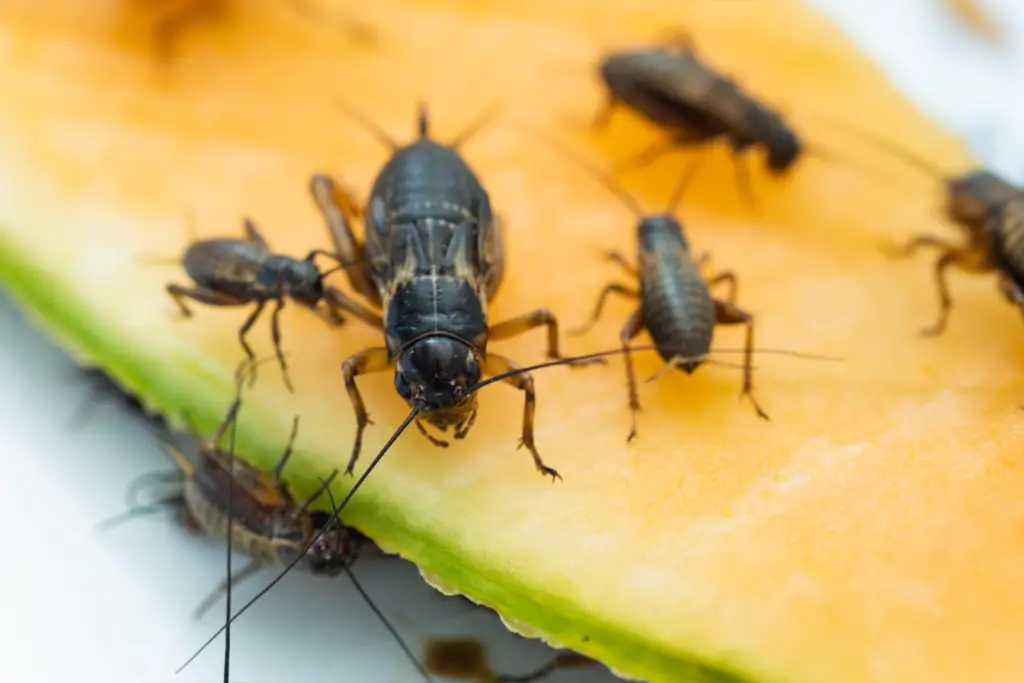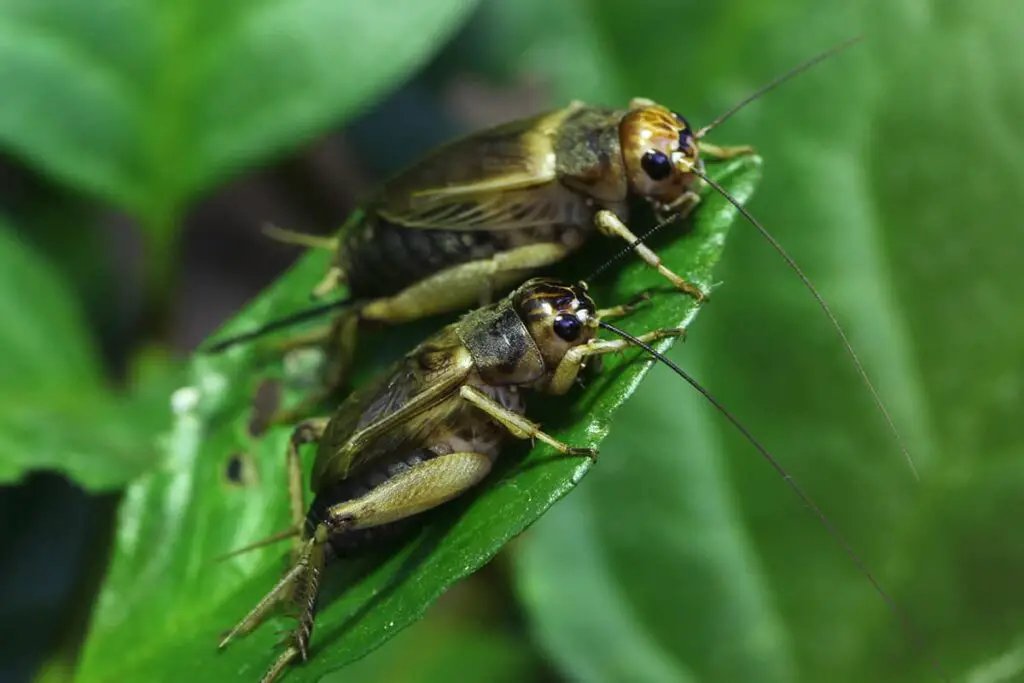
Feeding your crickets the right diet is crucial for their health and, in turn, the health of the pets that may feed on them. A variety of fruits and vegetables can be included in their diet to ensure they get the necessary nutrients. Think of these as the building blocks to gut-loading your crickets, which essentially means feeding them nutritious foods that will benefit your pet as well.
When it comes to fruits, crickets enjoy a range that includes apples and oranges, which are not only tasty for these insects but also easy for you to source. As for vegetables, carrots, potatoes, and leafy greens like romaine and kale are excellent choices. These options are rich in vitamins and minerals, helpful for the crickets’ growth and development.
Besides ensuring a balanced diet for the crickets, remember that the freshness of the food is just as important. Stale or rotten offerings might harm your crickets and, consequently, your pet. Always provide fresh produce and remember to remove any uneaten portions to prevent spoilage and maintain a clean environment for your tiny chirpers.
Nutritional Requirements of Crickets
Crickets need a balanced diet, just like you do. Their nutritional needs consist of proteins, carbohydrates, fats, and various vitamins and minerals to keep them healthy and active.
Proteins are crucial for their growth and development. Ensure your crickets have access to high-protein foods regularly.
Carbohydrates provide the energy crickets need to be lively. They can get these from fruits and vegetables you offer them.
Fats should be given in moderation, as they are dense in energy but can lead to unhealthy crickets if overconsumed.
Vitamins such as A, D, E, and B complex are vital for crickets. They help in maintaining good vision, strong exoskeletons, and overall health.
Necessary minerals include calcium and phosphorus, which support healthy development.
Here’s a simplified breakdown:
| Nutrient | Importance | Example Foods |
|---|---|---|
| Protein | Growth and repair | Leafy greens |
| Carbohydrates | Energy | Fruits, vegetables |
| Fats | Energy, in moderation | Small amounts of fruits |
| Vitamins | Various health benefits | Carrots, potatoes |
| Minerals | Exoskeleton and muscle health | Spinach, broccoli |
Remember, variety is key. Offering a range of fruits and vegetables ensures your crickets get all the nutrients they require, which in turn means they’ll be a better food source if you’re feeding them to pets.
Safe Fruits for Your Crickets
Providing a variety of fruits to your crickets can enhance their nutritional value as feeder insects. Here are some specific safe fruits to include in their diet:
Citrus Fruits
- Oranges: A slice of orange can offer your crickets hydration along with vitamin C. Just make sure to provide fresh pieces and remove them if not consumed within 24 hours to prevent mold.
- Apples: Apples are a great source of hydration and fiber for crickets. Dice them into small pieces to make it easier for the crickets to nibble on.
Berries
- Strawberries: Chopped strawberries, with their seeds and vitamin C, can be a nutritious treat for your crickets.
- Blueberries: Offer your crickets a few crushed blueberries; they’re rich in antioxidants and vitamins.
Tropical Fruits
- Bananas: A small amount of mashed banana can give crickets potassium and natural sugars for energy.
- Mango: Flesh from ripe mangoes is another excellent option, delivering vitamins A and C.

Vegetables Crickets Can Eat
When looking to vary your cricket’s diet, incorporating a range of vegetables can provide essential nutrients and add moisture to their diet. Here’s a guide on which vegetables to choose.
Leafy Greens
Leafy greens are a cricket favorite and an excellent source of nutrition for them. You can safely feed your crickets dark leafy greens such as kale, romaine, mustard greens, and collard greens. Tear the leaves into smaller pieces to make it easier for the crickets to eat.
Root Vegetables
Crickets also enjoy a variety of root vegetables. Carrots, sweet potatoes, and squash are particularly beneficial as they’re rich in vitamins. It’s best to offer these veggies in small, bite-sized chunks to accommodate the crickets’ tiny mouths.
Foods to Avoid Feeding Your Crickets
When caring for your crickets, it’s just as vital to know which foods to exclude from their diet. Certain fruits and vegetables may do more harm than good and should be kept out of your crickets’ habitat. Here’s a quick guide on what to avoid:
Sugary Foods: Avoid giving your crickets sugary treats like candies, as these can adversely affect their health. Excess sugar can lead to issues like obesity and could shorten their lifespan.
High-Fat Foods: Keep away from fatty foods, such as greasy snacks, which are not suitable for crickets.
Strongly Scented Items: Avoid foods with intense odors; they can cause stress and discomfort.
Processed Foods: As a rule of thumb, if it’s not fresh fruit or vegetable matter, think twice before adding it to their diet.
Here’s a simple table summarizing what to keep off your crickets’ menu:
| Food Type | Examples |
|---|---|
| Sugary Foods | Candies, Chocolate |
| High-Fat Foods | Chips, Fast Food |
| Strongly Scented | Onions, Garlic |
| Processed Foods | Cooked Meals, Canned Goods |
Always prioritize a balanced diet for your crickets that includes a variety of acceptable fruits, vegetables, and grains to keep them healthy and lively. Following these guidelines will ensure your crickets can thrive and serve as nutritious feed for your pets if that’s their purpose. Remember, a healthy cricket means a healthy pet!
Frequently Asked Questions
In this section, you’ll find targeted answers to common questions about feeding your crickets a variety of fruits and vegetables. This will help ensure they are a nutritious food source for your reptiles.
What type of vegetables are safe to feed crickets intended for reptiles?
Crickets can be fed a range of vegetables including carrots, squash, and leafy greens like kale and romaine lettuce. These not only provide your crickets with essential nutrients but also benefit the health of your reptiles when they consume the crickets.
Are there any fruits or vegetables that should be avoided when feeding crickets?
Yes, avoid feeding crickets onions, avocados, and chocolate as they can be toxic to both crickets and the pets that may consume them. Also, limit high-water content items like iceberg lettuce, which offer minimal nutritional value.
How can I ensure my crickets are nutritious for my pets by gut-loading them?
To gut-load crickets, provide them with nutritious food 24-48 hours before they are fed to your pet. This can include nutritious fruits, vegetables, and grains that will pass on the beneficial nutrients to the reptile when they eat the cricket.
Can crickets have citrus fruits, or will it harm them?
In small amounts, citrus fruits like oranges can be given to crickets as they provide moisture and some nutrients. However, they should not form the main part of the diet, as excessive amounts might harm the crickets and the pets that eat them.
What is the best way to provide water to crickets in captivity?
The best way to offer water to crickets is through wet sponges or water gel products to avoid the risk of drowning associated with open water sources. These methods will keep crickets well-hydrated without excess moisture increasing the risk of mold growth.
How can I prepare fruits and vegetables to feed crickets most effectively?
Chop the fruits and vegetables into small, manageable pieces for crickets to eat easily. Fresh items are ideal, but they should be free from pesticides and other chemicals. Remove any uneaten food daily to prevent mold and spoilage.
Driven by a passion for those tiny creatures that rule our world, we at Bug Domain strive to be your go-to resource for information on insects.




